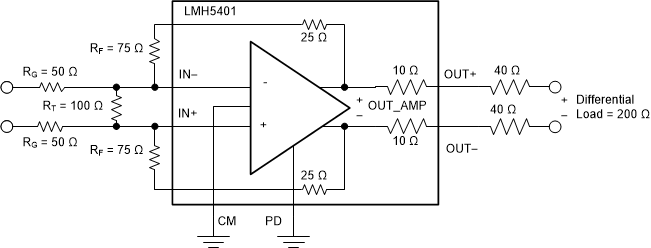ZHCSCW7D October 2014 – February 2018 LMH5401
PRODUCTION DATA.
- 1 特性
- 2 应用
- 3 说明
- 4 修订历史记录
- 5 Pin Configuration and Functions
-
6 Specifications
- 6.1 Absolute Maximum Ratings
- 6.2 ESD Ratings
- 6.3 Recommended Operating Conditions
- 6.4 Thermal Information
- 6.5 Electrical Characteristics: VS = 5 V
- 6.6 Electrical Characteristics: VS = 3.3 V
- 6.7 Typical Characteristics: 5 V
- 6.8 Typical Characteristics: 3.3 V
- 6.9 Typical Characteristics: 3.3-V to 5-V Supply Range
- 7 Parameter Measurement Information
- 8 Detailed Description
-
9 Application and Implementation
- 9.1 Application Information
- 9.2 Typical Application
- 9.3 Do's and Don'ts
- 10Power Supply Recommendations
- 11Layout
- 12器件和文档支持
- 13机械、封装和可订购信息
9.1.1 Stability
Two types of gain are associated with amplifiers: noise and signal gain. Noise gain (NG) is what is used to best determine the stability of an amplifier. The noise gain is the inverse of the voltage divider from the outputs back to the differential inputs. This gain is calculated by NG = (RF / RIN) + 1. For the LMH5401, NG values greater than three creates a stable circuit independent on how the signal gain is set. In Figure 63, for optimal performance choose RF within the values noted in this document (see the section for further information). Using too large of a resistance in the feedback path adds noise and can possibly have a negative affect on bandwidth, depending on the parasitic capacitance of the board; too low of a resistance can load the output, thus affecting distortion performance. When low gain stability is required, alter the noise gain by adding a dummy resistor (that is, RT in the differential configuration of Figure 63). By manipulating the noise gain with this addition, the amplifier can be stabilized without affecting signal gain. Evaluate the system at lower signal gains (G less than or equal to 2) if SNR can be tolerated with the higher noise gain configuration. In Figure 63, RS and RT in parallel combination affects the noise gain of the amplifier. RG and RF are the main gain-setting resistors and the addition of RT adjusts the noise gain for stability. Much of this stability can be simulated using the LMH5401 TINA model, depending on the amplifier configuration. The example in Figure 63 ( listed in row 1 of Table 1) uses the LMH5401, a signal gain of two , and a noise gain of five.
 Figure 63. Differential Stability
Figure 63. Differential Stability